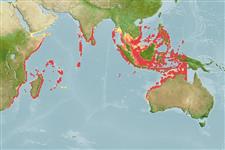Environment: milieu / climate zone / depth range / distribution range
Οικολογία
Θαλασσινό(ά) Υφαλόφιλο(α); εύρος βάθους 1 - 70 m (Ref. 4319). Tropical; 17°N - 33°S, 29°E - 137°E (Ref. 5222)
Indo-West Pacific: Kenya to South Africa (32°S) and east to the Watubela Group of the eastern Banda Sea. Not known from the Red Sea nor Persian Gulf.
Length at first maturity / Μέγεθος / Βάρος / Age
Maturity: Lm 23.0 range ? - ? cm
Max length : 55.0 cm TL αρσενικό/απροσδιόριστο; (Ref. 4319); μεγ. δημοσιευμένο βάρος: 2.7 kg (Ref. 4787)
Ραχιαίες άκανθες (συνολικά) : 11; Μαλακές ραχιαίες ακτίνες (συνολικά) : 16 - 17; Εδρικές άκανθες: 3; Μαλακές εδρικές ακτίνες: 8. Similar to E. maculatus but fewer spots and posterior ones elongated (Ref. 48635); Characterized by greyish brown color with pale blotches; head with widely scattered brown spots; diagonally elongated spots on body becoming more numerous posteriorly; dorsal fin with large dark blotches; ctenoid scales on body except cycloid on nape, thorax and lower abdomen; body with auxiliary scales; greatest depth of body 2.8-3.3 in SL; slightly rounded caudal fin; pelvic fins 1.8-2.3 in head length (Ref. 90102); head length 2.4-2.6 times in SL; flat to slightly convex interorbital area, convex dorsal head profile; preopercle angle with enlarged serrae and a shallow in indentation just above the angle; straight or slightly convex upper edge of operculum; posterior nostril not much larger than anterior nostril; maxilla reaches to or past vertical at rear edge of eye, ventral edge with blunt hook like process distally in fish larger than 35 cm SL; 2 rows of teeth on midlateral part of lower jaw (Ref. 89707).
Inhabit coral reefs or rocky areas and occasionally on sandy bottom. Feed mainly on crustaceans, especially crabs and stomatopods, rarely on small fishes, squids, and pelecypod flesh. Used in Chinese medicine (Ref. 12166). Solitary (Ref 90102).
Heemstra, P.C. and J.E. Randall, 1993. FAO Species Catalogue. Vol. 16. Groupers of the world (family Serranidae, subfamily Epinephelinae). An annotated and illustrated catalogue of the grouper, rockcod, hind, coral grouper and lyretail species known to date. Rome: FAO. FAO Fish. Synop. 125(16):382 p. (Ref. 5222)
IUCN Red List Status (Ref. 130435: Version 2024-1)
Threat to humans
Harmless
Human uses
αλιεία: Εμπορικό(ά)
Εργαλεία
Special reports
Download XML
Διαδικτυακές πηγές
Estimates based on models
Preferred temperature (Ref.
123201): 25.6 - 29, mean 28.2 °C (based on 716 cells).
Phylogenetic diversity index (Ref.
82804): PD
50 = 0.5000 [Uniqueness, from 0.5 = low to 2.0 = high].
Bayesian length-weight: a=0.01950 (0.01119 - 0.03397), b=3.13 (2.99 - 3.27), in cm total length, based on LWR estimates for this species & Genus-body shape (Ref.
93245).
Τροφικό Επίπεδο (Ref.
69278): 4.2 ±0.62 se; based on food items.
Ελαστικότητα (Ref.
120179): Μεσαίο(α), ελάχιστος χρόνος για διπλασιασμό πληθυσμού 1,4 - 4,4 έτη (Preliminary K or Fecundity.).
Fishing Vulnerability (Ref.
59153): Moderate vulnerability (42 of 100).
Nutrients (Ref.
124155): Calcium = 25.6 [12.7, 52.7] mg/100g; Iron = 0.458 [0.250, 0.937] mg/100g; Protein = 18.6 [17.1, 20.0] %; Omega3 = 0.127 [0.081, 0.202] g/100g; Selenium = 35 [21, 62] μg/100g; VitaminA = 194 [55, 690] μg/100g; Zinc = 1.19 [0.82, 1.66] mg/100g (wet weight); based on
nutrient studies.
